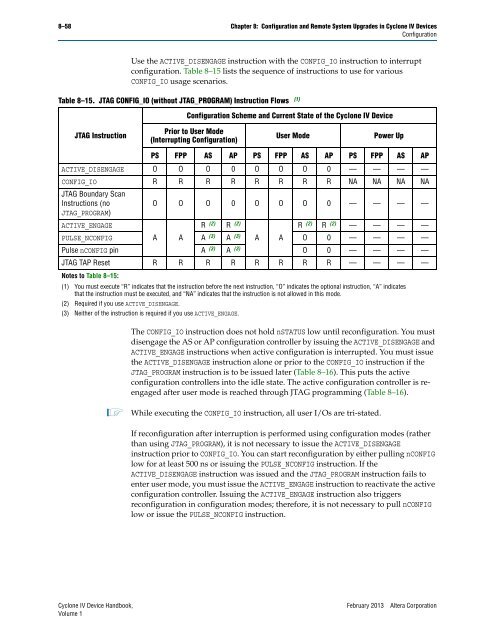Configuration and Remote System Upgrades in Cyclone IV ... - Altera
Configuration and Remote System Upgrades in Cyclone IV ... - Altera
Configuration and Remote System Upgrades in Cyclone IV ... - Altera
Create successful ePaper yourself
Turn your PDF publications into a flip-book with our unique Google optimized e-Paper software.
8–58 Chapter 8: <strong>Configuration</strong> <strong>and</strong> <strong>Remote</strong> <strong>System</strong> <strong>Upgrades</strong> <strong>in</strong> <strong>Cyclone</strong> <strong>IV</strong> Devices<br />
<strong>Configuration</strong><br />
Use the ACT<strong>IV</strong>E_DISENGAGE <strong>in</strong>struction with the CONFIG_IO <strong>in</strong>struction to <strong>in</strong>terrupt<br />
configuration. Table 8–15 lists the sequence of <strong>in</strong>structions to use for various<br />
CONFIG_IO usage scenarios.<br />
Table 8–15. JTAG CONFIG_IO (without JTAG_PROGRAM) Instruction Flows (1)<br />
JTAG Instruction<br />
<strong>Configuration</strong> Scheme <strong>and</strong> Current State of the <strong>Cyclone</strong> <strong>IV</strong> Device<br />
Prior to User Mode<br />
(Interrupt<strong>in</strong>g <strong>Configuration</strong>)<br />
User Mode Power Up<br />
PS FPP AS AP PS FPP AS AP PS FPP AS AP<br />
ACT<strong>IV</strong>E_DISENGAGE O O O 0 O O O 0 — — — —<br />
CONFIG_IO<br />
JTAG Boundary Scan<br />
R R R R R R R R NA NA NA NA<br />
Instructions (no<br />
JTAG_PROGRAM)<br />
O O O 0 O O O 0 — — — —<br />
ACT<strong>IV</strong>E_ENGAGE<br />
R (2) R (2)<br />
R (2) R (2) — — — —<br />
PULSE_NCONFIG A A A A A<br />
(3) A (3) O 0 — — — —<br />
Pulse nCONFIG p<strong>in</strong> A (3) A (3) O 0 — — — —<br />
JTAG TAP Reset R R R R R R R R — — — —<br />
Notes to Table 8–15:<br />
(1) You must execute “R” <strong>in</strong>dicates that the <strong>in</strong>struction before the next <strong>in</strong>struction, “O” <strong>in</strong>dicates the optional <strong>in</strong>struction, “A” <strong>in</strong>dicates<br />
that the <strong>in</strong>struction must be executed, <strong>and</strong> “NA” <strong>in</strong>dicates that the <strong>in</strong>struction is not allowed <strong>in</strong> this mode.<br />
(2) Required if you use ACT<strong>IV</strong>E_DISENGAGE.<br />
(3) Neither of the <strong>in</strong>struction is required if you use ACT<strong>IV</strong>E_ENGAGE.<br />
The CONFIG_IO <strong>in</strong>struction does not hold nSTATUS low until reconfiguration. You must<br />
disengage the AS or AP configuration controller by issu<strong>in</strong>g the ACT<strong>IV</strong>E_DISENGAGE <strong>and</strong><br />
ACT<strong>IV</strong>E_ENGAGE <strong>in</strong>structions when active configuration is <strong>in</strong>terrupted. You must issue<br />
the ACT<strong>IV</strong>E_DISENGAGE <strong>in</strong>struction alone or prior to the CONFIG_IO <strong>in</strong>struction if the<br />
JTAG_PROGRAM <strong>in</strong>struction is to be issued later (Table 8–16). This puts the active<br />
configuration controllers <strong>in</strong>to the idle state. The active configuration controller is reengaged<br />
after user mode is reached through JTAG programm<strong>in</strong>g (Table 8–16).<br />
1 While execut<strong>in</strong>g the CONFIG_IO <strong>in</strong>struction, all user I/Os are tri-stated.<br />
If reconfiguration after <strong>in</strong>terruption is performed us<strong>in</strong>g configuration modes (rather<br />
than us<strong>in</strong>g JTAG_PROGRAM), it is not necessary to issue the ACT<strong>IV</strong>E_DISENGAGE<br />
<strong>in</strong>struction prior to CONFIG_IO. You can start reconfiguration by either pull<strong>in</strong>g nCONFIG<br />
low for at least 500 ns or issu<strong>in</strong>g the PULSE_NCONFIG <strong>in</strong>struction. If the<br />
ACT<strong>IV</strong>E_DISENGAGE <strong>in</strong>struction was issued <strong>and</strong> the JTAG_PROGRAM <strong>in</strong>struction fails to<br />
enter user mode, you must issue the ACT<strong>IV</strong>E_ENGAGE <strong>in</strong>struction to reactivate the active<br />
configuration controller. Issu<strong>in</strong>g the ACT<strong>IV</strong>E_ENGAGE <strong>in</strong>struction also triggers<br />
reconfiguration <strong>in</strong> configuration modes; therefore, it is not necessary to pull nCONFIG<br />
low or issue the PULSE_NCONFIG <strong>in</strong>struction.<br />
<strong>Cyclone</strong> <strong>IV</strong> Device H<strong>and</strong>book, February 2013 <strong>Altera</strong> Corporation<br />
Volume 1
















